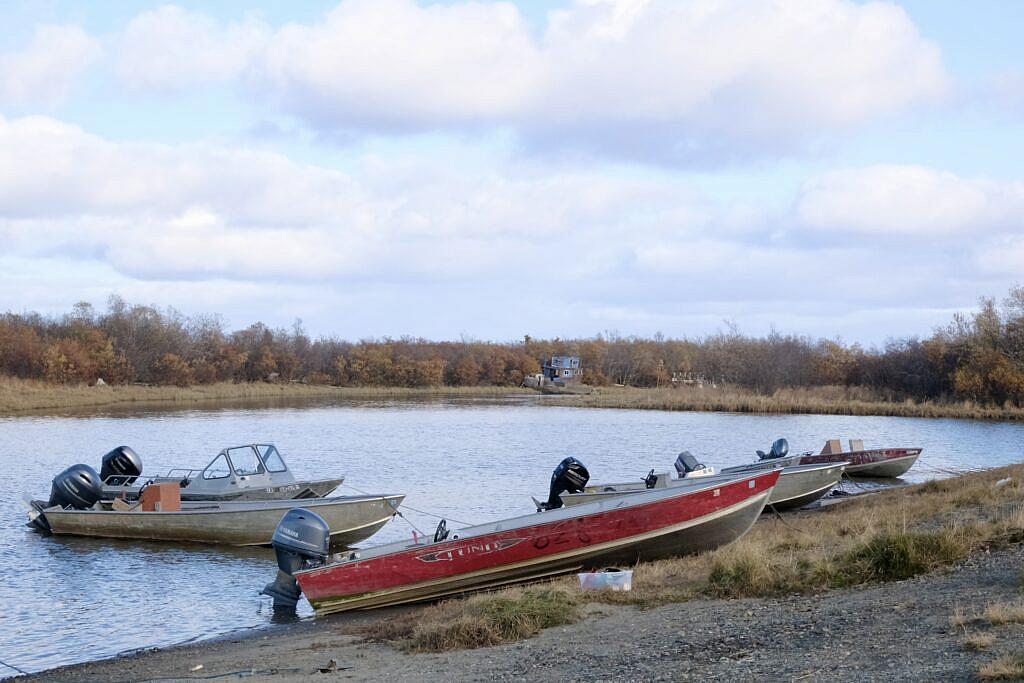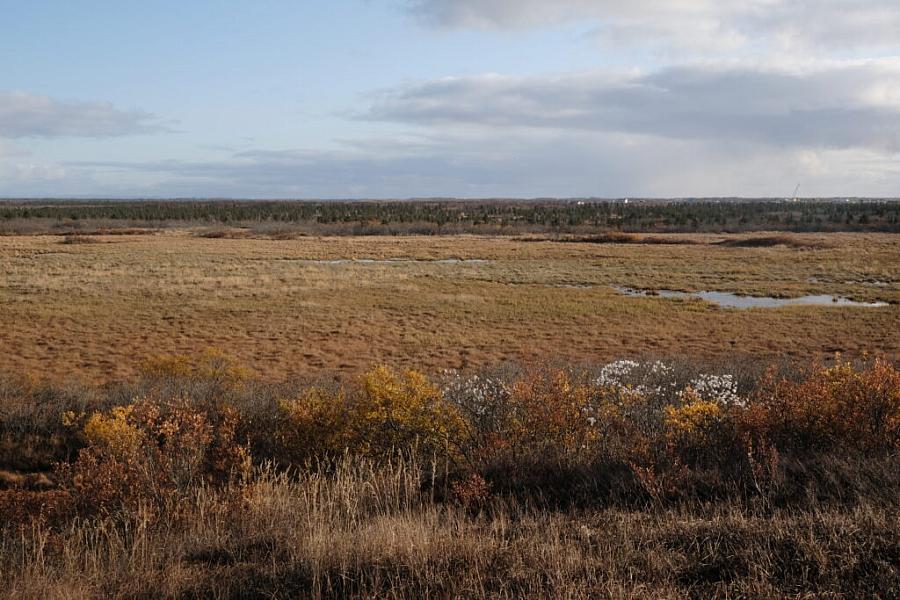With law enforcement sparse, Alaska villages build network of safety for survivors
The story was originally published by Alaska Beacon with support from our 2023 Domestic Violence Impact Fund

Boats rest on the shore of the Kuskokwim River in Bethel, a hub community in the Yukon Kuskokwim Delta. Boats are a main form of transportation in Western Alaska, where most communities are not connected by roads.
Photo by Claire Stremple/Alaska Beacon
Alaska is notoriously lacking in law enforcement for its remote communities, especially Alaska Native villages off the road system. These limitations put extra pressure on services in those communities to respond to violence after it happens, and a new program is aiming to help victims of violence.
In Emmonak, a village of about 800 residents near the terminus of the Yukon River, the women’s shelter has begun to train people known as “victim resource advocates” in the region’s smaller villages to connect people who have experienced violence there with shelter and care.
“The villages don’t have village police officers and we never know who to call, but hiring advocates in their community helps us provide services to those in need that are victims of domestic violence or sexual assault,” said Joann Horn, the executive director of the Emmonak Women’s Shelter.
“In the past it was hard. Sometimes we still have a hard time getting hold of law enforcement,” Horn said. “In the villages it’s hard where they have no law enforcement, it takes days for them to get a response.”

The tundra in the Yukon-Kuskokwim Delta is seen in the evening sun on Oct. 11, 2023. Outside the hub community of Bethel, most villages in the region do not have ready access to victim services or law enforcement.
Photo by Claire Stremple/Alaska Beacon
She said in the years before the shelter trained resource advocates, help was difficult to come by for women who experienced domestic violence or sexual assault — they would have to go to the tribal office to call the shelter in Emmonak and then wait in the tribal office until a plane could come get them, Horn said.
Brent Hatch, now a patrol sergeant for the Alaska State Troopers in Fairbanks, spent years responding to domestic violence cases in remote parts of Alaska. He said the Alaska State Troopers are severely understaffed, but must still respond to crimes over vast distances.
“I think we’re down over 50 troopers; their spots are just empty. And so the troopers that we do have to cover all of the work that our missing troopers are not able to do,” he said. “So just the fact that we’re so incredibly short-staffed, it puts a great burden on a lot of people.”
Hatch described having to “triage” calls when he worked in bush Alaska, and said the troopers that are on duty are responsible for such large geographic areas that travel can slow down the response considerably.
Before we had these village resource advocates, we’d always have a hard time if it was late at night and the woman or the victim was walking around outside with no place to go.
– Tammi Long, Emmonak Women's Shelter
“I’ve had instances where I’ve had to spend over eight hours on a snowmachine to get to a location to investigate domestic violence calls because a flight was not an option due to weather,” he said. “I’ve had instances on numerous occasions where I’ve spent eight to 12 hours in a boat going upriver to deal with situations like this.”
Hatch has been with the Troopers since 2008 and said staffing has always been an issue, but that lately it has been even harder.
“The last several years especially, we are losing more people than we’re able to recruit. And the ones we recruit, we’re having a really, really difficult time retaining them,” he said, adding that he attributes some of that to a cultural shift in how law enforcement is perceived by the public.
Village resource advocates
The Emmonak shelter trains the victim resource advocates, who then advertise that they work for the shelter and list their contact information and the services they provide in their communities.
Horn said it has helped get more people from remote villages to safety at the Emmonak Women’s Shelter. “In the past we never used to have a contact person. So having a resource advocate in those villages that we provide services to makes a difference,” she said.
Tammi Long, an employee of the Emmonak Women’s Shelter, said the program is new for them — it started in February of last year.
“That really, really helped us with getting these women and children into safe homes if for some reason they cannot travel to the shelter,” she said. “Before we had these village resource advocates, we’d always have a hard time if it was late at night and the woman or the victim was walking around outside with no place to go.”
The shelter has village resources advocates in Alakanuk, Pitkas Point, Russian Mission, Pilot Station and Marshall. It is working to fill vacancies in Nunam Iqua, Kotlik and Mountain Village. Horn said they also have a trained coordinator who connects with the other advocates weekly.
Horn said the positions are hard to fill. “Once they get a crisis call, they have to take them (the victim) into their homes, and they’re afraid for them to come to their home because the perpetrator might come after that family,” Horn said.
But overall, Horn and Long say the program has helped communities.
“It has been successful so far,” Long said. “We’re getting more and more crisis calls and more and more women and children wanting to come to the shelter. I mean, it’s unfortunate, but we do have more data to report since the village resource advocates started.”
Leaders in solutions to violence
More than 130 miles away in Anvik, Tami Truett Jerue, the executive director of Alaska Native Women’s Resource Center, said there’s the same lack of access to law enforcement, but there are no safe homes for survivors of dometic or sexual violence either.
“In my community, you don’t even have access to 911. There’s no health care, there’s no law enforcement, and you have to get on a plane to get in and out of there.”
Jerue has worked to end domestic violence and increase safety for Alaska Native people for decades. Last year U.S. Interior Secretary Deb Haaland appointed Jerue to the Not Invisible Act Commission, which is an advisory committee that includes law enforcement, Tribal leaders, federal partners, service providers, family members of missing and murdered individuals, and survivors.
Jerue said what the shelter in Emmonak is doing is a good example of how Tribes can be leaders in addressing domestic violence statewide.
She said Alaska Native people tend to be on the periphery of victim services and safety even when they are the majority of people who need services — and she wants to see that change.
“We want to change the current rates of violence that we see against our Tribal communities and Tribal people in our community, but outside our communities as well,” she said.
Currently, she said, police reports are necessary to access a main federal funding source for victims of crime, set aside in the U.S. Victims of Crime Act.
That can disenfranchise small, predominantly Alaska Native communities like hers, that do not have law enforcement. But in recent years, the federal government has added a funding stream to address that inequity.
Tribal Victim Services Set-Aside
The federal Tribal Victim Services Set-Aside program brought a historic amount of money to Alaska Native Tribes and Tribes across the nation to spend on victim services, Jerue said. Her organization is working with Alaska Tribes who have not previously had the budgets for such services.
Crime Victim Specialist Kristi Travers has traveled to communities across the state to help Tribes build sustainable programs through direct training and technical assistance.
“If we’re here to protect victims and help victims, then their voices need to be front and center every time,” said Travers, who has worked with domestic violence and sexual assault programs that serve Indigenous communities for the past 16 years.
When the Tribal Services Set-Aside program began in 2018 and 2019 there was a huge push for Tribes to apply for the funds, she said. But not all Tribes had the resources to write grants for competitive funding, even if their communities could benefit from services.
In 2020, at the request from Tribes across the country, the federal government changed the program to a formula grant program, instead of making Tribes compete for the money.
“We’ve had a massive expansion in the number of villages that are starting or enhancing their victim services programs because of this funding,” Travers said.
This summer, the U.S. Justice Department announced that $22 million will go to 67 Alaska Tribes. Jerue said this should add to the number of Alaska Native communities that can build solutions that fit their needs.

